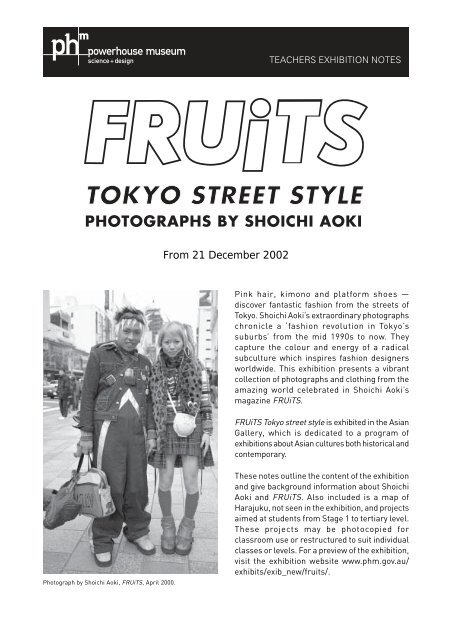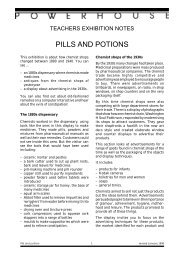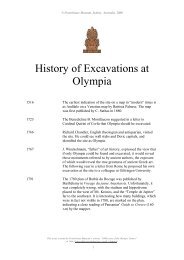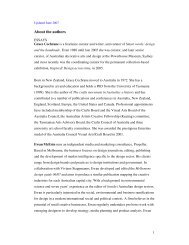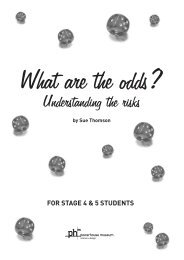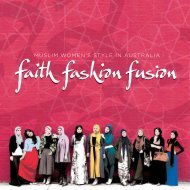fruits teachers notes.pmd - Powerhouse Museum
fruits teachers notes.pmd - Powerhouse Museum
fruits teachers notes.pmd - Powerhouse Museum
You also want an ePaper? Increase the reach of your titles
YUMPU automatically turns print PDFs into web optimized ePapers that Google loves.
Photograph by Shoichi Aoki, FRUiTS, April 2000.<br />
From 21 December 2002<br />
Pink hair, kimono and platform shoes —<br />
discover fantastic fashion from the streets of<br />
Tokyo. Shoichi Aoki’s extraordinary photographs<br />
chronicle a ‘fashion revolution in Tokyo’s<br />
suburbs’ from the mid 1990s to now. They<br />
capture the colour and energy of a radical<br />
subculture which inspires fashion designers<br />
worldwide. This exhibition presents a vibrant<br />
collection of photographs and clothing from the<br />
amazing world celebrated in Shoichi Aoki’s<br />
magazine FRUiTS.<br />
FRUiTS Tokyo street style is exhibited in the Asian<br />
Gallery, which is dedicated to a program of<br />
exhibitions about Asian cultures both historical and<br />
contemporary.<br />
These <strong>notes</strong> outline the content of the exhibition<br />
and give background information about Shoichi<br />
Aoki and FRUiTS. Also included is a map of<br />
Harajuku, not seen in the exhibition, and projects<br />
aimed at students from Stage 1 to tertiary level.<br />
These projects may be photocopied for<br />
classroom use or restructured to suit individual<br />
classes or levels. For a preview of the exhibition,<br />
visit the exhibition website www.phm.gov.au/<br />
exhibits/exib_new/<strong>fruits</strong>/.
Curriculum links<br />
FRUiTS: Tokyo street style links directly to the<br />
following curriculum outcomes but is expected to<br />
be popular with students of all ages and interests.<br />
With clear and simple themes, there is great<br />
opportunity for expansion through hands-on<br />
activities, creative responses and, for older<br />
students, projects and research relating to fashion,<br />
society and culture, photography and design.<br />
>> Primary<br />
• Human Society and Its Environment<br />
• Creative Arts<br />
• LOTE — Japanese language studies<br />
>> Secondary<br />
• Society and Culture<br />
• Design and Technology<br />
• Textile Design<br />
• LOTE — Japanese language studies<br />
>> Tertiary<br />
• Fashion<br />
• Society and Culture<br />
• Design<br />
• Asian studies<br />
• Photography<br />
• Japanese Language and Culture<br />
Drawing by Maki, a FRUiTS reader, published in FRUiTS<br />
December 2000.<br />
About the exhibition<br />
In addition to over 70 photographs by Shoichi<br />
Aoki, the exhibition includes a variety of objects.<br />
Moving through the exhibition in a clockwise<br />
direction you will see:<br />
• examples of Shoichi Aoki’s FRUiTS magazine<br />
• clothing by Japanese labels Takuya Angel and<br />
Baby, the stars shine bright<br />
• examples of Shoichi Aoki’s STREET magazine<br />
• Tokyo street-style outfits worn by people<br />
featured in FRUiTS magazine<br />
• clothing and accessories by designers popular<br />
in Harajuku: Vivienne Westwood, Martin<br />
Margiela, 20471120 and Christopher Nemeth<br />
• Japanese designer label T-shirts<br />
• a limited-edition Astro Boy doll by Ohya.<br />
Two short videos in the exhibition explore<br />
different aspects of Tokyo street style. One<br />
includes a brief interview with Shoichi Aoki. A<br />
CD-ROM allows you to flick through the pages<br />
of several issues of FRUiTS magazine.<br />
Also on display outside the exhibition are a<br />
selection of tin toys made in Japan between 1950<br />
and 1969.<br />
TEACHERS NOTES 2
FRUiTS: TOKYO STREET STYLE<br />
Shoichi Aoki’s photographs document<br />
a revolutionary Japanese fashion<br />
movement that emerged on the<br />
streets of Harajuku, Tokyo, in the mid<br />
1990s. Unlike most fashion<br />
movements it was led not by<br />
designers but by young people,<br />
wearing an extreme mix of traditional<br />
Japanese dress, handmade and<br />
secondhand clothing, and designer<br />
fashion.<br />
In June 1997 Shoichi Aoki established<br />
a monthly magazine, which he still<br />
publishes, to ‘report on the cutting<br />
edge of youth fashion’ in Harajuku.<br />
He named the magazine FRUiTS to<br />
reflect the colour and freshness of the<br />
movement. The photographs in this<br />
exhibition were taken between 1997<br />
and 2002 and were originally<br />
published in FRUiTS.<br />
FRUiTS issue 43, December 2000.<br />
Here ‘fashion’ is more about the art of ‘putting<br />
things on’ than about the art of making clothes.<br />
Shoichi Aoki<br />
TEACHERS NOTES 3
SHOICHI AOKI<br />
Shoichi Aoki is photographer, editor<br />
and publisher of FRUiTS. Born in<br />
Tokyo in 1955, he worked as a<br />
computer programmer in the 1970s<br />
before leaving Japan for Europe,<br />
determined never to take another<br />
company job. After returning to<br />
Tokyo, Shoichi Aoki and Noriko<br />
Kojima started the magazine STREET.<br />
Launched in 1985, STREET introduced<br />
European avant-garde street fashion<br />
to Japan and is still in publication.<br />
Shoichi Aoki believes that fashion is<br />
an important form of communication;<br />
he is interested in the ways people<br />
express themselves through dress,<br />
rather than the individual garments<br />
they wear. For most of the<br />
photographs in FRUiTS he has<br />
recorded the subject’s name and age,<br />
as well as a short description of their<br />
outfit, current obsessions and ‘point<br />
of fashion’ or motivations.<br />
Shoichi Aoki, 2002.<br />
Fashion tends to be seen as a lower form of art.<br />
But in fact, in the beginning when people started<br />
to adorn the body or paint on the body wasn’t<br />
fashion, more than its functionality, born to<br />
express the difference between the self and<br />
others as a form of identification?<br />
If we think that consciousness of the difference<br />
between ourself and others marks the beginning<br />
of humanity, then fashion is probably the first<br />
art form to which humans gave birth. This made<br />
me interested in fashion. Here ‘fashion’ is more<br />
about the art of ‘putting things on’ than about<br />
the art of making clothes.<br />
Shoichi Aoki<br />
TEACHERS NOTES 4
FRUiTS STYLES<br />
The diverse styles in FRUiTS are<br />
continually evolving and often<br />
unique. Some popular looks are wamono,<br />
a mix of Japanese and western<br />
styles; cyber, a ‘futuristic’ combination<br />
of bright colours and plastics; decora,<br />
in which toys and plastic jewellery are<br />
worn so that their clinking sound<br />
adds a ‘musical’ dimension to the<br />
outfit; and punk.<br />
Clothing based on cartoon characters<br />
such as Sailor Moon is also<br />
fashionable. Called cosplay (costume<br />
play) the style refers not only to<br />
dressing as a specific character but<br />
also as a generic ‘type’, for example<br />
a waitress or nurse. Overtly cute or<br />
kawaii outfits, most often in shades of<br />
pink, have a strong presence in<br />
Harajuku as do frilly doll-like ‘Lolita’<br />
looks. ‘Elegant Gothic Lolita’, a<br />
blacker version of Lolita style, is<br />
inspired by the elaborate outfits of<br />
Japanese ‘visual rock’ bands. Rap,<br />
hip hop and skate styles are also<br />
popular.<br />
Top to bottom: Lolita, cyber and decora styles. Photographs by<br />
Shoichi Aoki from FRUiTS May 1998, June 1999, September 2001.<br />
TEACHERS NOTES 5
FASHION IN JAPAN<br />
Elaborate clothing, including the<br />
exaggerated beauty of geisha dress<br />
and the complexity of samurai<br />
armour, has a long history in Japan.<br />
Pattern, colour and layers of<br />
garments were used to indicate<br />
wealth and social status. Western<br />
clothing was introduced in the Meiji<br />
period (1868–1912) and has been<br />
prevalent since World War II.<br />
According to Shoichi Aoki “the<br />
average Japanese person’s<br />
perception of their own traditional<br />
kimono culture was of an avantgarde<br />
and unconventional medium —<br />
adventurous, bright and colourful …<br />
Western modes of dressing seemed,<br />
by contrast, drab and limiting.”*<br />
In the 1970s and 80s designers Issey<br />
Miyake, Rei Kawakubo (Comme des<br />
Garçons) and Yohji Yamamoto<br />
created an international fashion<br />
sensation with innovative garments<br />
that drew on Japanese and western<br />
traditions. When Harajuku street style<br />
emerged in the mid 1990s one of its<br />
extraordinary features was the<br />
combination of traditional dress —<br />
kimono, obi sashes and geta sandals<br />
— with designer fashion and<br />
alternative streetwear such as punk.<br />
* Shoichi Aoki, FRUiTS, Phaidon Press, 2001<br />
Ryuko was photographed by Shoichi Aoki for FRUiTS, April<br />
1998, wearing a handmade skirt, shoes by Yohji Yamamoto and<br />
a bag by Issey Miyake.<br />
Because western clothing has a short history in<br />
Japan, there is a strong tendency for people to<br />
dress in the same style as each other. Essentially<br />
this tendency has not changed. In Japan, having<br />
a different style is a kind of risk. Even the<br />
designer brand boom of the 1980s did not<br />
change that. People only took suggestions from<br />
the designers — in the same manner as<br />
everyone else.<br />
Therefore the fashion movement that came<br />
about in Harajuku was a revolution. This kind of<br />
fashion was not ‘suggested’ by designers, but<br />
rather, the fashion of the young inspired the<br />
designers. On the streets of Harajuku, there was<br />
no risk in having a different style. In fact it was<br />
considered worthwhile.<br />
Shoichi Aoki<br />
TEACHERS NOTES 6
HARAJUKU<br />
Harajuku is situated between two of<br />
Tokyo’s major commercial centres,<br />
Shibuya and Shinjuku. The opening<br />
of the Meiji Jingu Shrine in the 1920s<br />
first brought visitors to Harajuku, but<br />
it was the 1964 Tokyo Olympics that<br />
transformed the quiet residential<br />
area. The excitement surrounding the<br />
games attracted young people to<br />
Harajuku, and it is still one of Tokyo’s<br />
most vibrant and fashionable areas.<br />
Harajuku was the birthplace of<br />
several crazes including takenokozoku<br />
— a 1970s fad where brightly<br />
dressed people danced to recorded<br />
music on the side of the road — and<br />
similarly rock ’n’ roller-zoku and<br />
band-zoku. The area’s Elvis Presley<br />
impersonators are infamous. Between<br />
1977 and 1998 a section of road in<br />
Harajuku was closed to traffic on<br />
Sundays, creating Hokoten or<br />
‘pedestrian paradise’.<br />
Dancing Elvises in Harajuku.<br />
Hokoten<br />
One of the primary reasons this kind of youth<br />
culture came out of Harajuku was Hokoten<br />
(‘pedestrian paradise’). Hokoten happened every<br />
Sunday when one kilometre of Harajuku’s main<br />
road was blocked to cars. This section of road<br />
became a public square. The idea of Hokoten is<br />
precious because the concept of a public square<br />
did not exist in Japan. Many young people<br />
dressed in their finery and gathered there. This<br />
kind of fashion spread to other days in Harajuku<br />
and influenced fashion nationwide.<br />
Hokoten was terminated in 1998 and Harajuku<br />
gradually returned to its original state. The<br />
momentary avant-garde and creative fashion<br />
has mostly disappeared. The photos introduced<br />
here are the precious documentation of the<br />
fashion movement. Still, publication of FRUiTS<br />
continues … I am looking forward to the same<br />
kind of explosion happening again.<br />
Shoichi Aoki<br />
TEACHERS NOTES 7
��<br />
�����<br />
���<br />
����<br />
����<br />
�<br />
�������<br />
������<br />
�����<br />
��<br />
������� ����<br />
���<br />
�����<br />
���<br />
�������<br />
����<br />
����<br />
����<br />
�������<br />
����<br />
�<br />
��������<br />
����������<br />
�����������������<br />
�����<br />
���������<br />
������������<br />
�<br />
������<br />
������<br />
������������<br />
��������<br />
�����������������<br />
������������<br />
����������������<br />
���������� �<br />
�<br />
�������<br />
�����<br />
���<br />
����<br />
��������������<br />
��������������<br />
������������������<br />
����������������<br />
��<br />
��<br />
��<br />
�<br />
��<br />
�<br />
��<br />
��<br />
�������<br />
��<br />
�<br />
�<br />
�������������<br />
���������<br />
����������<br />
���������<br />
����<br />
���<br />
������<br />
��������<br />
���������<br />
����<br />
������������<br />
������<br />
���������<br />
������������<br />
����<br />
�������<br />
������<br />
������������������<br />
�����������������<br />
����<br />
����������� �<br />
�������� ��<br />
��<br />
�������������<br />
������<br />
�������<br />
����������<br />
�ö���<br />
��������������<br />
����<br />
������<br />
����<br />
������<br />
���������������<br />
���<br />
�������������<br />
�����<br />
�����<br />
������<br />
�����<br />
������������������<br />
����<br />
�����������<br />
��������<br />
��������<br />
���<br />
����<br />
������<br />
����<br />
������<br />
�����<br />
��<br />
���������<br />
���<br />
���<br />
��������<br />
����<br />
���������<br />
���������<br />
��<br />
��<br />
��<br />
��<br />
��<br />
��<br />
��<br />
��<br />
��<br />
��<br />
��<br />
��<br />
��<br />
��<br />
��<br />
��<br />
����<br />
����<br />
���<br />
����������<br />
���<br />
�����������<br />
Harajuku map from FRUiTS, May 2000.
1. FRUiTty fashion paper dolls<br />
page 10–11<br />
Recommended: early stage 1 — stage 3<br />
Type: individual activity<br />
Instructions<br />
1. Photocopy pages 10–11 for each student.<br />
2. Students draw their own face on the paper doll.<br />
3. Students decorate and/or colour-in clothing,<br />
hair and shoes.<br />
4. Students cut-out paper doll and all accessories.<br />
Notes<br />
As younger students will require assistance with<br />
cutting, a small selection of clothing and<br />
accessories is advised.<br />
160 gsm paper is recommended as it is durable<br />
but can still be used in a regular photocopier.<br />
However regular copy paper may still be used.<br />
2. Homemade Harajuku style<br />
Recommended: stages 1–6<br />
Type: class or group project<br />
Instructions<br />
Part 1<br />
1. Class discussion: what is fashion?<br />
2. Class discussion: what does Shoichi Aoki<br />
think fashion is?<br />
‘“Fashion” is more about the art of “putting<br />
things on” than about the art of making<br />
clothes’. Shoichi Aoki<br />
For example, you may have a simple T-shirt,<br />
pair of pants, jacket and shoes. If you add a<br />
wild hairstyle, leg-warmers and accessories,<br />
you suddenly have a Tokyo ‘street style’ look.<br />
Part 2<br />
3. Gather and prepare scraps of fabric, ribbon etc.<br />
4. Students bring a selection of own clothing<br />
from home.<br />
Student projects and activities<br />
5. Students dress up using own clothing<br />
and extra fabric etc to create a ‘street style’<br />
look.<br />
Part 3 (optional)<br />
6. Photograph each student and hang photos on<br />
wall to create the class’s own ‘street style’<br />
exhibition.<br />
7. Students write own labels with the following<br />
information: name, age and style (or<br />
influences).<br />
Notes<br />
For older students the project can be extended<br />
in the following ways:<br />
Part 1: in groups, students research a style of<br />
fashion and how that ‘look’ evolved.<br />
Part 2: students collect recycled materials in<br />
order to create their own ‘street style’ fashion.<br />
Part 3: students photograph each other either<br />
in the school setting or local street setting to<br />
produce their own exhibition.<br />
3. Fresh FRUiTS competition<br />
Open to: design students studying fashion,<br />
design or photography at secondary school or<br />
tertiary level<br />
Type: individual or group project<br />
Final entry date: Friday 20 June 2003<br />
Students create their own ‘street style’ look and<br />
photograph themselves in a street setting.<br />
Finalists will be displayed at the <strong>Powerhouse</strong><br />
<strong>Museum</strong>.<br />
For full details contact:<br />
Rita Bila<br />
Ph: (02) 9217 0380<br />
Email: ritab@phm.gov.au<br />
TEACHERS NOTES 9
FRUiTty fashion paper dolls<br />
TEACHERS NOTES 10
TEACHERS NOTES 11
Books<br />
Aoki, Shoichi, FRUiTS, Phaidon, New York, 2001<br />
Baudot, Francois, Yohji Yamamoto, Thames and<br />
Hudson, London,1997<br />
Benaim, Laurence, Issey Miyake, Thames and<br />
Hudson, London,1997<br />
Buckley, Sandra (ed), Encyclopedia of<br />
contemporary Japanese culture, Routledge,<br />
London and New York<br />
Bullis, Douglas, Fashion Asia, Thames and<br />
Hudson, New York, 2000<br />
Grand, France, Comme des Garçons, Thames<br />
and Hudson, London, 1998<br />
Lunn, Stephen, ‘Made in Japan’, Australian<br />
Magazine, 16–17 March 2002<br />
Takamura, Zenshu, Roots of street style, Books<br />
Nippan, Tokyo, 1996<br />
Teunissen, José, Made in Japan, Centraal<br />
<strong>Museum</strong>, Utrecht, 2001<br />
Wilcox, Claire, Radical fashion, Harry N Abrams,<br />
London, 2001<br />
>> Internet<br />
About the exhibition<br />
• www.phm.gov.au/exhibits/exib_new/<strong>fruits</strong>/<br />
For more information on the exhibition FRUiTS:<br />
Toyko street style, photographs by Shoichi Aoki,<br />
visit the <strong>Powerhouse</strong> <strong>Museum</strong>’s website<br />
http://www.phm.gov.au<br />
Further reading and resources<br />
About FRUiTS<br />
• http://www.<strong>fruits</strong>-mg.com/pc/english/e/<br />
index.html<br />
• http://www.slucky.net/lolita/giantrobot.html<br />
(interview with Aoki)<br />
About Harajuku style<br />
• http://www.rebeccamead.com/2002/<br />
2002_03_18_art_shopping.htm<br />
• http://www.insite-tokyo.com/column/<br />
douglas/index8.html<br />
• www.morbidoutlook.com/fashion/articles/<br />
2002_07_gothlolita.html<br />
About the designers featured in the exhibition<br />
• http://www.historyofcostume.com/<br />
historyofashion/margiela.html<br />
• http://www.babyssb.co.jp<br />
• www.virtualrunway.com<br />
• www.isseymiyake.com<br />
• www.yohjiyamamoto.co.jp<br />
• http://www.superlovers.co.jp/english/<br />
index.html<br />
• http://ip.tosp.co.jp/i.asp?i=ihpTA<br />
(Takuya Angel, in Japanese)<br />
• http://ja.tezuka.co.jp/ohya/<br />
(Ohya, in Japanese)<br />
Please note<br />
These websites were available and suitable at the time of<br />
publication. We advise that <strong>teachers</strong> should check sites before<br />
recommending them to students.<br />
For more information about education support<br />
or your booking, contact Education and Visitor<br />
Services at the <strong>Powerhouse</strong> <strong>Museum</strong>:<br />
Telephone — (02) 9217 0222<br />
Fax — (02) 9217 0441<br />
Email — edserv@phm.gov.au<br />
© 2003 Trustees of the <strong>Museum</strong> of Applied Arts and Sciences. This publication is copyright. Apart from fair dealing for the purposes of research, study, criticism or review, or as<br />
otherwise permitted under the Copyright Act, no part may be reproduced by any process without written permission.<br />
TEACHERS NOTES 12


